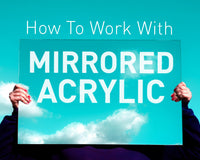The cover of our Easter 2019 D&T Update features this nifty clip together acrylic case. This is a super easy project, showcasing design, materials, and a small amount of soldering. The design files for the project are available, so you can quickly cut one for yourself.  The website Thingiverse is used as it's where this simple clip together box design was first found. The design works well with acrylic and extremely well with manufactured woods like laser friendly MDF and Ply. Grab the files here.
The website Thingiverse is used as it's where this simple clip together box design was first found. The design works well with acrylic and extremely well with manufactured woods like laser friendly MDF and Ply. Grab the files here.
Laser Cut Clip Together Mono Amplifier Case:
A step-by-step guide on how to assemble this project follows. The original project was cut from Acid Green Perspex, this tutorial uses Gold Metallic Perspex. It is photographed on Orange Perspex Sheet. We used one of our amplifier kits for the build, you can find a pre-built mono amplifier kit here.
Prepare the file for laser cutting
The file provided is a dxf, this is Drawing Interchange Format, or Drawing Exchange Format. Which is a Computer Aided Design (CAD) data file format developed by a design company called Autodesk. With the specific reason to enable data interoperability between AutoCAD and other programs. It has become somewhat of a standard for CAD files used for laser cutting, and most laser cutter software packages will read it.
 The dxf file is compatible with most laser cutter software packages
The dxf file is compatible with most laser cutter software packages
The file is colour coded so it is possible to cut the internal parts first, so they won't fall into your laser cutter. The settings shown are for a 40W laser cutter.
Cut out the design
Each laser cutter will vary, but we trust you will know how to operate your laser cutter. The next stage is to cut the design.
 Our 40W laser cutting out the clip together box design
Our 40W laser cutting out the clip together box design
There is a stage here where the protective coating is removed. The laser cutter does the work for you. It would be possible to cut using a fret saw, but that would require a lot more work.
Prepare the Mono Amplifier Kit
This could be done while the laser cutter is cutting the box. For speed, the pre-built Mono Amplifier kit was used. In this kit, the majority of the soldering is done, and only the speaker, battery box, and headphone jack need soldering onto the board. This was made easier by adding a light coating of solder to the ends of the wires once they were stripped ready to solder in, otherwise threading the stripped wire through the strain relief holes was a little tricky. The assembled Mono Amplifier Kit looks like this.
 The Kitronik Pre-build Mono Amplifier Kit
The Kitronik Pre-build Mono Amplifier Kit
Assemble the case
 A view of the case laid out flat.
A view of the case laid out flat.
The first step in assembly is to thread through the battery cage and headphone jack through the L-shaped part of the case. This is the middle part of the case, it holds the back of the speaker and also the PCB for the mono amp.
 Threading the wires through the L shaped part
Threading the wires through the L shaped part
With the wires threaded through screws, the nuts can then be added to the corners of the PCB to prepare it for mounting on the L shaped part.
 Using 10mm screws in each corner the PCB can be attached to the L shaped part
Using 10mm screws in each corner the PCB can be attached to the L shaped part
With the screws in the corner of the PCB it can then be attached to the L shaped part with four more M3 nuts.
 Pay close attention to how this is attached.
Pay close attention to how this is attached.
The next parts of assembly involve laying parts out on the desk and also working out for yourself how it goes together. The images that follow will show you, but it will be easiest if you have worked it out for yourself first. Slot one side into the front piece of the box
Slot one side into the front piece of the box
Next, the L shaped part is added to the assembly. Also, ensure the speaker is lined up with the holes on the front of the box and slotted into the circular part of the L shaped part.
 The speaker placed onto the grill area and into the hole on the L shaped part
The speaker placed onto the grill area and into the hole on the L shaped part
Slot and hold the second side into place. Add the second side and hope it all holds together for the next part
Add the second side and hope it all holds together for the next part
Now add the door, which will also act as a battery compartment.  Adding the hinged part for the battery cage can be a little fiddly, the next step pulls everything together.
Adding the hinged part for the battery cage can be a little fiddly, the next step pulls everything together.
Next, add one of the end parts, these are both the same, so either will do. Then, clip the larger hole over the solid lug (topmost in the image below). Putting an end part over the assembly before clicking into place.
Putting an end part over the assembly before clicking into place.
With a soft click, the end part will hold the assembly together, hopefully, all of the side parts have also kept themselves together.  End part clipped into place.
End part clipped into place.
Now that the hinged door can be used, flip it up and slide the headphone jack through one of the holes on the side. This is so you can easily connect the Mono Amp to your phone.  Slot the headphone jack through one of the side holes in the case
Slot the headphone jack through one of the side holes in the case
Clip on the remaining end piece, then place the battery box into the case.  Clip on the last piece, using the same technique as the other end.
Clip on the last piece, using the same technique as the other end.
Insert two AA batteries and then close the rear of the case. The, stand it up, plug it in ,and admire your creation! The completed Clip Case Mono Amplifier Kit
The completed Clip Case Mono Amplifier Kit
Finally, we hope you have enjoyed this build tutorial and look forward to hearing your feedback.
©Kitronik Ltd – You may print this page & link to it, but must not copy the page or part thereof without Kitronik's prior written consent.






